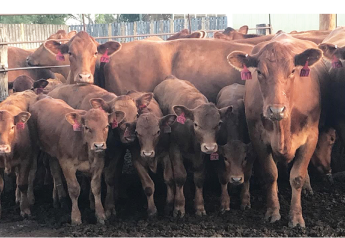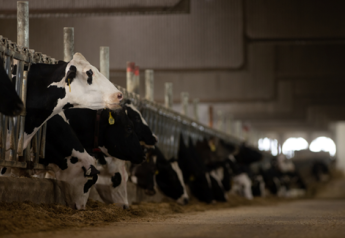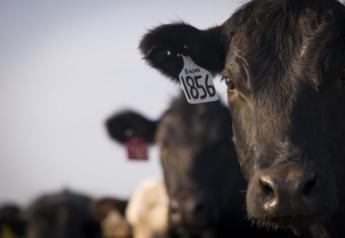Dealing with Anaplasmosis in your herd

Anaplasma marginale is an organism that lives in red blood cells and causes the only major tick-borne disease in the US affecting cattle production. Transmission is by transfer of infected red blood cells from infected to susceptible cattle. Ticks (Dermacentor spp.) are biological vectors and are of greatest importance because A. marginale replicates within the tick and can be maintained there for up to a year. Deer are not reservoirs but they often carry ticks infected with disease. Anaplasma can also be spread by biting insects (mosquitoes, horse flies, stable flies) and/or blood contaminated instruments such as needles, dehorners, ear taggers, castration tools, and implant guns. A university trial showed that 6 out of 10 calves exposed to an injection needle used on a carrier calf became infected so changing needles is a critical part of disease control. Also, transmission can occur during pregnancy that can lead to fetal death, abortion, or calves born persistently infected with anaplasmosis.
There are generally four phases of disease:
Incubation - This is the time from exposure to the time that Anaplasma bodies can be detected in blood. This varies from 4-8 weeks (or longer) and depends on the size of the original dose. The organism slowly reproduces in the bloodstream during which time the animal remains healthy. When approximately 1% of the red blood cells are infected, reproduction speeds up and the number of organisms doubles every day. This leads to rapid disease progression as the immune system tries to destroy the parasite and destroys the red blood cells simultaneously, causing severe anemia. Outbreaks of Anaplasmosis in September, October, and November in Kentucky are actually associated with vector exposure in June and July.
Developmental Stage - This is the stage of disease when characteristic clinical signs appear lasting 4-9 days:
a. Fever - Very first sign. (104-107°F)
b. Anemia - Pale around eyes, muzzle, teats
c. Watery thin blood which causes increased heart and respiratory rate
d. Marked icterus - yellow mucous membranes.
e. Lethargy/Weakness/Lags behind herd (May fall and be unable to stand)
f. Inappetance/Dehydration/Weight Loss
g. Constipation/Rumen Stasis
h. Dramatic drop in milk production
i. Reproductive disorders/abortion/infertility in bull
j. Age Related Mortality: <6 months old: seldom see any problems 6 months-3 years old: increasingly ill 3 years old and older: 30-50% death rate if untreated
k. May present as “sudden death” in a highly susceptible or immune compromised animal such as a high producing dairy cow.
Treatment with tetracycline is essential in the clinical stage of disease as well as supportive therapy for the anemia. No injectable antibiotic is formally approved for treatment so any form is “extra label” and must be done under veterinary direction. A single intramuscular injection of long acting oxytetracycline at 22 mg/kg of body weight (or 10 mg/lb BW IM) will often stop any clinical cases or those in the late incubation stage. Severely affected cattle may die due to stress associated with going through the chute. If treating all adult cattle in the herd with injectable oxytetracycline, remember it will only delay the disease if given very early on in the incubation stage. Therefore it is also recommended to immediately begin feeding chlortetracycline (CTC) at the high end of the control dose (2mg/lb BW/day) to effectively treat the herd.
Convalescent Stage - This phase lasts until normal blood values return and is characterized by an increase in red blood cells. Recovery occurs over a 2-3 month span and cows frequently lose weight and/or abort calves during this time.
Carrier Stage - Animals that recover remain carriers for the rest of their lives unless cleared with antibiotics. No symptoms are associated with this lifelong persistent infection. Unidentified carriers are the most common source of infection for future outbreaks. It is a good idea to blood test the herd to determine anaplasmosis prevalence if the owner can stand the cost. Positive cattle can then be segregated and treated with 2 mg CTC/ lb BW/ day for at least 60 days. Depending on the number of cattle involved you could also consider 4-5 injections of oxytetracycline at 10 mg/lb, 5 days apart. Clearance of the carrier state is best achieved in the non-vector season. Retest the herd 4 - 6 months later. Consider culling or retreating persistently blood test positive cattle. Institute biosecurity practices such as clean needles and blood test newborn calves and new arrivals.
To prevent active infection during the vector season, feed CTC in a free-choice feed at the higher level of the approved range (0.5-2mg/lb BW/day for cattle over 700 pounds) for 40-60 days. Remember, oral CTC is worthless if the animals are not consuming sufficient amounts of medicated feed. Producers should therefore monitor intakes. Aureomycin© is the only brand of CTC approved as a free choice feed for Anaplasmosis control. Extra-label use of feed additives is illegal and strictly prohibited by producers, veterinarians or nutritionists.
Another method of control is through vaccination. Kentucky has recently joined the list of states approved by the USDA for sales of the anaplasmosis vaccine marketed by University Products LLC of Baton Rouge, La. The vaccine has provided good protection against anaplasmosis throughout the United States and Puerto Rico. The vaccine has been used in cows in all stages of pregnancy with no problems being reported. The vaccine recommendations include a 2 dose regimen given 4 weeks apart with annual revaccination
The UKVDL recommends the Anaplasmosis cELISA test on serum to detect infection and active carriers. Blood should be collected in serum (red top) tubes and serum removed by spinning the collection tube down and transferring the serum to a labeled transfer tube. Transport specimens to the lab as soon as possible after collection (overnight ship with cold packs). It is also recommended that a blood sample (purple top tube) be submitted for a CBC with differential in order to assess the degree of anemia and regeneration. Please visit the UKVDL web site for additional information.







